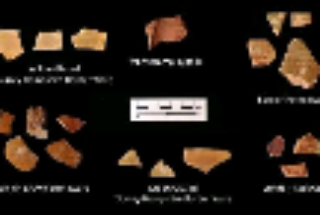
n 1585, the English settlers reached the New World and established a colony on the island of Roanoke, in what is now part of North Carolina, only to mysteriously disappear. The colonists’ fate has become one of American history’s most enduring mysteries, and now archaeologists have uncovered new evidence suggesting that the survivors splintered into multiple camps and assimilated into the Indigenous population.
Thanks to a secret message on a centuries-old map, a team from the First Colony Foundation, a North Carolina nonprofit dedicated to researching the history of the ill-fated Walter Raleigh colony, was able to uncover colonial-era pottery they believe belonged to some of the 115 men, women, and children abandoned on Roanoke in 1587.
When the colony’s governor, John White, returned from a three-year journey back to England in 1590, all traces of the settlement and its inhabitants had disappeared. The only clue left behind was the word “Croatoan,” the former name of what is now Hatteras Island, carved into a post.
There are many theories about what became of Roanoke, none of which are particularly pleasant. Historians have posited that the colonists were killed by Native Americans or hostile Spaniards, or that they died off due to disease or famine, or were victims of a deadly storm.
Fragments of early English pottery were found by archaeologists with the First Colony Foundation. The leading theory is that they belonged to survivors of the lost Roanoke colony. Photo courtesy of the First Colony Foundation.
But researchers uncovered a new lead in 2012 while examining a map that White had painted of the Elizabethan-era United States, titled La Virginea Pars. Hidden in invisible ink, presumably to guard information about the colonies from the Spanish, were the outlines of two forts, one 50 miles west of Roanoke—the same distance away that the colonists had told White they planned to move, according to his writings.
The First Colony Foundation’s team of archaeologists, led by Nick Luccketti, set out to investigate the site in Bertie County, North Carolina, in 2015. Promisingly, the possible settlement was close to a Native American village called Mettaquem, typical of early European settlements.
This 16th-century map of what is now coastal North Carolina appears to show a fort concealed under a patch and visible only by backlighting that may have been where survivors settled after abandoning Roanoke Island. Photo by Stuart Conway, courtesy of the trustees of the British Museum.
There was no sign of a fort, but just outside the village wall the archaeologists found two dozen shards of English pottery at what’s been dubbed Site X. Ground-penetrating radar revealed another possible dig site two miles away.
The search continued in December 2019 at what’s been dubbed Site Y, yielding many more fragments of ceramics from different parts of Europe. The fragments, which come from vessels used for food preparation and storage, suggest the presence of long-term residents.
This Spanish olive jar is from Jamestown. Archaeologists with the First Colony Foundation uncovered in Bertie County fragments of a similar piece that may have belonged to members of the Roanoke colony. Photo courtesy of the First Colony Foundation.
“What has been found so far at Site Y in Bertie County appears to me to solve one of the greatest mysteries in Early American history, the odyssey of the ‘Lost’ Colony,” William M. Kelso, emeritus director of archaeology and research at Jamestown Rediscovery, said in a statement.
Although the experts haven’t ruled out the possibility that the artifacts may have been left behind by colonists from Jamestown, founded in 1607, Luccketti is confident that his find is evidence of a group of relocated Roanoke colonists. Notable is a lack of English pipes, which were ubiquitous among Jamestown settlers, suggesting the ceramics date from an earlier period.
The First Colony Foundation during excavations at Site Y, now believed to be settled by the lost Roanoke survivors. Photo courtesy of the First Colony Foundation.
But not everyone is buying this explanation for the colony’s ultimate fate. “I am skeptical,” says Charles Ewen, an archaeologist at East Carolina University, told National Geographic. “They are looking to prove rather than seeking to disprove their theory, which is the scientific way.”
Another theory about the colony is that the settlers moved to Croatoan—hence the apparently not-so cryptic note. “Bertie was the heart of enemy territory,” Scott Dawson, cofounder of the Croatoan Archaeological Society, told the Virginian-Pilot. “It is the last place they would go. The colony literally wrote down they relocated to Croatoan.”
Earlier this year, Dawson published a book, The Lost Colony and Hatteras Island, detailing the findings of the society’s 10 years of excavations at Hatteras Island led by Mark Horton, an archaeologist at the University of Bristol, in England.
A partial handle of an Elizabethan rapier found on Hatteras Island. Croatoan Archeological Society.
“Basically, the historical evidence says [Hatteras is] where they went,” Horton told the New York Times in September. He is preparing a peer-reviewed study presenting his findings on the island, which include a rapier hilt, late 16th-century gun hardware, and a slate writing tablet fragment.
Of course, both recent archaeologist finds could be evidence of the Roanoke’s fate.
“Possibly,” said Jamestown Rediscovery President and First Colony board member James Horn in a statement, “a small group went to Croatoan Island in the fall or winter of 1587 to wait for John White to return, while the remainder moved inland.”
*story by artnet.news